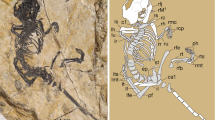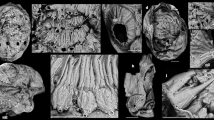Abstract
The choana, a unique ‘internal nostril’ opening from the nasal sac into the roof of the mouth, is a key part of the tetrapod (land vertebrate) respiratory system. It was the first component of the tetrapod body plan to evolve, well before the origin of limbs, and is therefore crucial to our understanding of the beginning of the fish–tetrapod transition. However, there is no consensus on the origin of the choana despite decades of heated debate1,2,3,4,5,6,7,8,9; some have claimed that it represents a palatally displaced external nostril4,6, but others have argued that this is implausible because it implies breaking and rejoining the maxillary–premaxillary dental arcade and the maxillary branch of nerve V2,6. The fossil record has not resolved the dispute, because the choana is fully developed in known tetrapod stem-group members8,10,11. Here we present new material of Kenichthys, a 395-million-year-old fossil fish from China12,13,14, that provides direct evidence for the origin of the choana and establishes its homology: it is indeed a displaced posterior external nostril that, during a brief transitional stage illustrated by Kenichthys, separated the maxilla from the premaxilla.
This is a preview of subscription content, access via your institution
Access options
Subscribe to this journal
Receive 51 print issues and online access
$199.00 per year
only $3.90 per issue
Buy this article
- Purchase on Springer Link
- Instant access to full article PDF
Prices may be subject to local taxes which are calculated during checkout



Similar content being viewed by others
References
Jarvik, E. On the structure of the snout of crossopterygians and lower gnathostomes in general. Zool. Bidrag Uppsala 21, 235–675 (1942)
Panchen, A. L. The nostrils of choanate fishes and early tetrapods. Biol. Rev. 42, 374–420 (1967)
Jarvik, E. Basic Structure and Evolution of Vertebrates Vol. 1 (Academic, London, 1980)
Rosen, D. E. et al. Lungfishes, tetrapods, paleontology, and plesiomorphy. Bull. Am. Mus. Nat. Hist. 167, 157–276 (1981)
Maisey, J. G. Heads and tails: a chordate phylogeny. Cladistics 2, 201–256 (1986)
Panchen, A. L. & Smithson, T. R. Character diagnosis, fossils and the origin of tetrapods. Biol. Rev. 62, 341–438 (1987)
Forey, P. L. in The Biology and Evolution of Lungfishes (eds Bemis, W. E., Burggren, W. W. & Kemp, N.) 39–74 (Alan R. Liss, New York, 1987)
Schultze, H.-P. in Origins of the Higher Groups of Tetrapods: Controversy and Consensus (eds Schultze, H.-P. & Trueb, L.) 29–67 (Cornell Univ. Press, Ithaca, 1991)
Ahlberg, P. E. A re-examination of sarcopterygian interrelationships, with special reference to the Porolepiformes. Zool. J. Linn. Soc. 103, 241–287 (1991)
Long, J. A., Campbell, K. S. W. & Barwick, R. E. Osteology and functional morphology of the osteolepiform fish Gogonasus andrewsae Long, 1985, from the Upper Devonian Gogo Formation, Western Australia. Rec. W. Aust. Mus. Suppl. 53, 1–89 (1997)
Ahlberg, P. E. & Johanson, Z. Osteolepiforms and the ancestry of tetrapods. Nature 395, 792–794 (1998)
Chang, M. M. & Zhu, M. A new Middle Devonian osteolepidid from Qujing, Yunnan. Mem. Assoc. Australas. Palaeontol. 15, 183–198 (1993)
Zhu, M. & Wang, J.-Q. On the Early–Middle Devonian boundary in Qujing, Yunnan. Acta Stratigr. Sin. 20, 58–63 (1996)
Chang, M. M. & Yu, X. B. Reexamination of the relationship of Middle Devonian osteolepids—fossil characters and their interpretations. Am. Mus. Novitat. 3189, 1–20 (1997)
Lebedev, O. A. Morphology of a new osteolepidid fish from Russia. Bull. Mus. Natl Hist. Nat. Paris 17, 287–341 (1995)
Chang, M. M. . The Braincase of Youngolepis, a Lower Devonian Crossopterygian from Yunnan, South-western China Thesis, Stockholm Univ. (1982)
Tong-Dzuy, T. & Janvier, P. Les Vertébrés du Dévonien inférieur du Bac Bo oriental (provinces de Bac Thaï et Lang Son, Viêt Nam). Bull. Mus. Natl Hist. Nat. Paris 12, 143–223 (1990)
Johanson, Z. & Ahlberg, P. E. A complete primitive rhizodont from Australia. Nature 394, 569–572 (1998)
Long, J. A. A new rhizodontiform fish from the Early Carboniferous of Victoria, Australia, with remarks on the phylogenetic position of the group. J. Vert. Paleontol. 9, 1–17 (1989)
Clement, G. Evidence for lack of choanae in the Porolepiformes. J. Vert. Paleontol. 21, 795–802 (2001)
Ahlberg, P. E., Clack, J. A. & Lukťevičs, E. Rapid braincase evolution between Panderichthys and the earliest tetrapods. Nature 381, 61–64 (1996)
Chang, M. M. & Yu, X. B. Structure and phylogenetic significance of Diabolichthys speratus gen. et sp. nov., a new dipnoan-like form from the early Devonian of southeastern Yunnan, China. Proc. Linn. Soc. N.S.W. 107, 171–184 (1984)
Zhu, M., Yu, X. B. & Ahlberg, P. E. A primitive sarcopterygian fish with an eyestalk. Nature 410, 81–84 (2001)
Bemis, W. E. & Grande, L. Early development of the actinopterygian head. I. External development and staging of the paddlefish Polyodon spathula. J. Morphol. 213, 47–83 (1992)
Ashique, A. M., Fu, K. & Richman, J. M. Endogenous bone morphogenetic proteins regulate outgrowth and epithelial survival during avian lip fusion. Development 129, 4647–4660 (2002)
Hu, D. & Helms, J. The role of sonic hedgehog in normal and abnormal craniofacial morphogenesis. Development 126, 4873–4884 (1999)
Zhang, Z. et al. Rescue of cleft palate in Msx1-deficient mice by transgenic Bmp4 reveals a network of BMP and Shh signaling in the regulation of mammalian palatogenesis. Development 129, 4135–4146 (2002)
Acknowledgements
We thank M. M. Chang for advice and discussions, M. Yang for artwork, and X. Lu for specimen preparation. This work was supported by the Special Funds for Major State Basic Research Projects of China and the Chinese Foundation of Natural Sciences. P.E.A. thanks the Royal Society and Chinese Academy of Sciences for supporting his visit to Beijing in 2002 through their exchange programme.
Author information
Authors and Affiliations
Corresponding author
Ethics declarations
Competing interests
The authors declare that they have no competing financial interests.
Supplementary information
Supplementary Methods
Summary of the phylogenetic analysis. The character list. The data matrix. The consensus tree of 18 most parsimonious trees. The analysis based on a new expanded character suite confirms that Kenichthys is the most basal member of the tetrapod stem group. (DOC 709 kb)
Rights and permissions
About this article
Cite this article
Zhu, M., Ahlberg, P. The origin of the internal nostril of tetrapods. Nature 432, 94–97 (2004). https://doi.org/10.1038/nature02843
Received:
Accepted:
Issue Date:
DOI: https://doi.org/10.1038/nature02843
This article is cited by
-
The Silurian-Devonian boundary in East Yunnan (South China) and the minimum constraint for the lungfish-tetrapod split
Science China Earth Sciences (2021)
-
Fin modules: an evolutionary perspective on appendage disparity in basal vertebrates
BMC Biology (2017)
-
A Devonian tetrapod-like fish reveals substantial parallelism in stem tetrapod evolution
Nature Ecology & Evolution (2017)
-
The earliest known stem-tetrapod from the Lower Devonian of China
Nature Communications (2012)
-
Muddy tetrapod origins
Nature (2010)
Comments
By submitting a comment you agree to abide by our Terms and Community Guidelines. If you find something abusive or that does not comply with our terms or guidelines please flag it as inappropriate.



